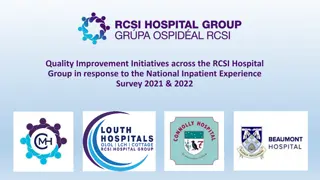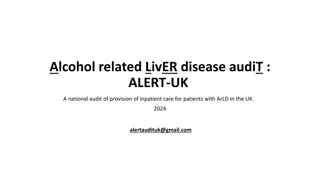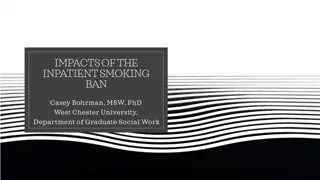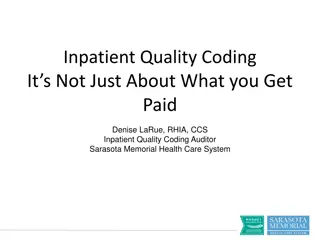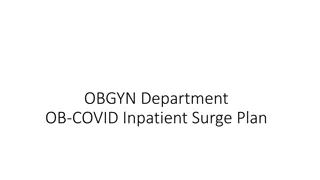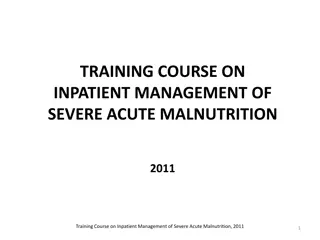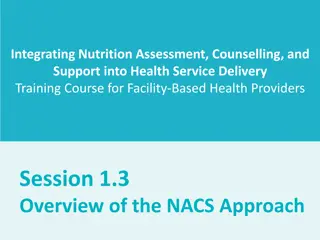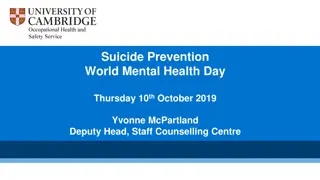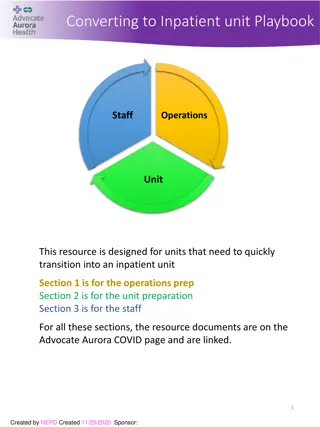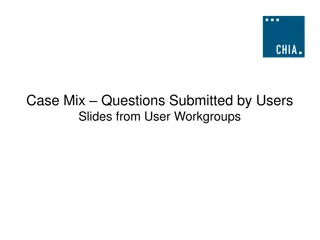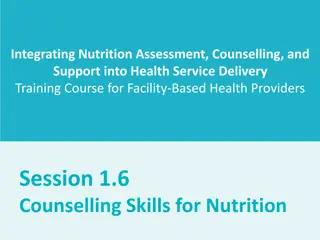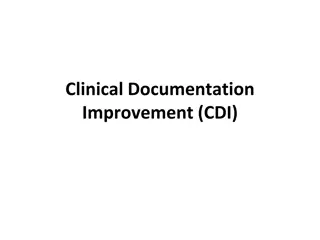Levels of Inpatient Counselling
Orienting and engaging individuals in the inpatient unit, providing counseling at different stages to address mental state, family issues, and prepare for discharge. Handling high arousal in psychosis and understanding and supporting individuals with depression.
Download Presentation

Please find below an Image/Link to download the presentation.
The content on the website is provided AS IS for your information and personal use only. It may not be sold, licensed, or shared on other websites without obtaining consent from the author.If you encounter any issues during the download, it is possible that the publisher has removed the file from their server.
You are allowed to download the files provided on this website for personal or commercial use, subject to the condition that they are used lawfully. All files are the property of their respective owners.
The content on the website is provided AS IS for your information and personal use only. It may not be sold, licensed, or shared on other websites without obtaining consent from the author.
E N D
Presentation Transcript
Clearing the confusion Admission to the inpatient unit is very challenging. For some it is a refuge and safety For most it is fearsome Having a breakdown and losing self-trust Being with people with mental illness /drug problems Social shame Being a burden to the family
So. Counselling has a few different levels Orienting people to the ward and reducing the trauma of admission Engaging people enough to assess and document peoples mental state (client & family accounts and observation) First line counselling (managing risk, debriefing trauma, engagement, identifying psychological themes) Advanced counselling (exploring family and life issues & family upbringing, psychological development and psychological challenges) Psychoeducation (for condition management and in preparation for discharge)
What and who has inspired you when you have been confused and down E.g., Philosophy Wisdom Spirituality Family
Psychosis Take into account high arousal (be calm, clear, kind, reduce conflict) cognitive confusion (explain processes & provide structure) delusional & hallucinatory experiences (be aware, be safe, explain procedures carefully) Families can give good insights as to what the patient can tolerate and what is sensitive from their own experience of the patient.
Depression Listen and try to understand the depth of the hopelessness even if it doesn t make sense. Be open to discussing suicidal feelings, hopelessness, and worthlessness (they are very common) Be alert to suicide & self-harm risk even when patient is getting better Be empathic about dilemmas but don t try to fix the patient s life problems Encourage behavioural activation during ward stay Go slow and be patient. Many people see their own depression as physical or like a mysterious illness. I encourage patients to view depression as due to factors in their own lives. Only a small number of patients have primarily biological depression
Anxiety Manage your own anxiety Encourage patient in emotional self-management (breathing, writing, meditation) Assume the presenting anxiety is a surface manifestation for other topics of anxiety Model calm problem-solving and perspective-taking Chain analysis- monitor the patients activities and relationships and what increases and decreases the anxiety Anxious patients make counsellors anxious. They often want things fixed now and view problems as terribleWe can buy time by calmly suggesting proper assessment over a few days
Drugs and Alcohol Patients want help with dealing with the side effects of withdrawal (depression, anxiety, restlessness, sleep disturbance). We can out withdrawal into perspective. Listen for history of trauma, specific conflicts /problems as these might be a focus of treatment later on. Be clear about rules. People would drug and alcohol problems are used to operating outside the rules. Observe and focus on evidence. Be calm in the face of the patient s anger and outrage. Motivation is the big issue here. Patients can be regretful of behaviour and very passionate about their aims but fail to deliver in the long run. We need to be realistic about the attractions of drug and alcohol use but straightforward about the difference between functional use and dysfunctional use.
Basic Calming strategies Hopefulness (inspirations) Sharing Normalising mental health issues while treating them seriously A new narrative from Hopeless case to Survivor Encourage problem-solving everybody has option- we just haven t seen them yet Breathing/ mindfulness/ writing/ monitoring





